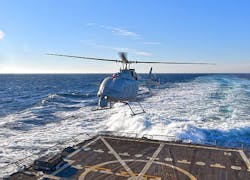Northrop Grumman to install Leonardo surface-search radar aboard Navy MQ-8C unmanned helicopters
PATUXENT RIVER NAS, Md. – Military unmanned aerial vehicle (UAV) experts at Northrop Grumman Corp. will install a sophisticated surface-search radar system on the U.S. Navy's fleet of MQ-8C Fire Scout shipboard unmanned helicopters.
Officials of the Naval Air Systems Command at Patuxent River Naval Air Station, Md., announced a $32.9 million order Wednesday to the Northrop Grumman Aerospace Systems segment in San Diego to install the AN/ZPY-8 Osprey MM radar, built by Leonardo MW Ltd. in Edinburgh, Scotland, aboard the Navy MQ-8C fleet.
Northrop Grumman is the designer and systems integrator of the MQ-8C Fire Scout, an unmanned version of the Bell 407 helicopter from Bell Helicopter Textron Inc. in Fort Worth, Texas. The manned version of the Bell 407 seats seven, can carry a useful load of 2,347 pounds, flies as fast as 140 knots, and has a range of 324 nautical miles.
The long-range MQ-8C will fly from the decks of destroyers and other naval surface warships to extend the surveillance and reconnaissance range of the Navy's surface fleet that are operating away from aircraft carriers and land-based aircraft.
This order is part of the MQ-8C Fire Scout radar Original Equipment Manufacturer (OEM) program. The Navy chose Leonardo MW Ltd. to provide the MQ-8C radar last fall. Leonardo MW is an arm of the Leonardo-Finmeccania corporation in Rome, which oversees the company's aerospace, defence and security operations in the United Kingdom.
Related: Navy chooses shipboard data link from L3 Communications-West to communicate with UAVs
The contract modification to Northrop Grumman includes completing the integration design; systems engineering technical reviews; modifications to Fire Scout software; testing; A-kit fabrication and installation; and flight tests.
The Leonardo Osprey MM is a multi-mode surveillance radar for helicopters and fixed-wing aircraft that provides second-generation active electronically scanned array (AESA) surveillance capability. It brings together wide-azimuth and -elevation electronically scanned fixed antennas with a compact radar signal processor and multi-channel receiver.
Employing high-frequency radio waves, an Osprey-equipped MQ-8C Fire Scout can detect targets at long ranges, at night, and in poor visibility to detect distant threats.
The small-size Osprey MM provides high-performance sea surveillance against difficult targets, as well as land surveillance with wide-swath high-resolution ground mapping, small and low-speed ground target indication, air-to-air surveillance, tracking, and intercept. It can interleave modes rapidly and provide scan-independent beam steering.
Related: Next-generation Fire Scout unmanned helicopters to have increased range and payload
Osprey MM comes with a variety of antenna sizes, depending on the azimuth coverage to facilitate the MQ-8C's operation to and from unprepared surfaces. It offers persistent surveillance and target detection from high altitudes to enhance MQ-8C fuel efficiency.
Osprey MM’s flexible configuration, with antenna size and installation options, its low SWaP, air cooled line replaceable units (LRU), and its open standard interfaces all simplify its integration. At the core of the Osprey MM’s AESA radar design is its ability to tolerate individual element failure. It offers reduced maintenance.
On Wednesday's order Northrop Grumman will do the work in Rancho Bernardo and Santa Clarita, Calif.; and in Edinburgh, Scotland, and should be finished by May 2020.
For more information contact Northrop Grumman Aerospace Systems online at www.northropgrumman.com, Leonardo MW Ltd. at www.uk.leonardocompany.com, or Naval Air Systems Command at www.navair.navy.mil.
Learn more: search the Aerospace & Defense Buyer's Guide for companies, new products, press releases, and videos

